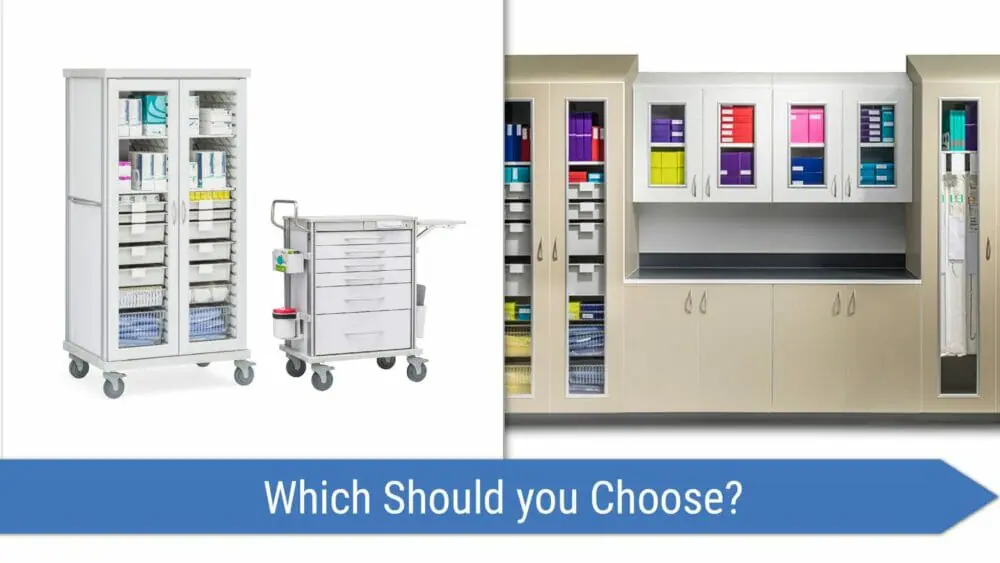
Anyone working in healthcare knows that a clean, well-stocked, organized storage system can feel like a ray of sunshine during the most hectic days. Both stationary and mobile storage options are available for healthcare facilities, but how do you decide which type of storage solution fits your needs?
Stakeholders, from facility architects to nurses, should be involved in deciding what storage solutions work best for each unit. Patient safety may be the most critical factor that impacts how and where facilities store medical supplies.
Decision-makers may also want to consider the type of unit, typical staff workflows, traffic patterns, and any applicable manufacturer’s storage instructions.
This article will examine the advantages and disadvantages of fixed and mobile storage options and provide examples of how each may help to protect facility assets, provide safe patient care, and maximize efficiency.
Permanent Storage
Advantages of stationary storage:
- Controlled storage
- Humidity and temperature-controlled storage rooms or cabinets provide a stable environment for supplies and medications. For example, endoscope drying cabinets offer a controlled environment that can be located near or in procedure rooms.
- Controlled access
- Locked stationary cabinets or rooms provide a safe place to store controlled substances or hazardous materials.
- Clean environment
- Supplies can be stored in closed cabinets, drawers, or on shelving in sterile supply rooms, reducing the risk of contamination.
- Vertical storage
- Fixed storage cabinets configured to fit available wall space keeps extra supplies from taking up valuable floor space.
- Adjustable organization
- Flexible interior storage allows staff to arrange supplies for optimal efficiency, while clear doors and labeling increase visibility and reduce time-consuming searches.
Disadvantages of stationary storage:
- Higher cost
- Built-in cabinetry typically costs more than mobile units.
- Immobile
- Relocating fixed storage cabinets involves extensive renovations.
Traditionally, hospital units revolved around a central nursing station and storage room where nurses retrieved supplies and charted. Large units centered around one supply storage area require nurses to travel long distances, limiting time spent on direct patient care.
Today, it is more common to have decentralized nursing stations spread around the unit. Placing storage cabinets near each nursing station can reduce the time nurses spend locating and transporting supplies while increasing the time nurses spend monitoring and caring for patients.
Mobile Storage
While fixed cabinets provide a customizable, consistent, and safe way to store frequently used supplies, mobile carts, and cabinets provide flexibility to meet changing patient care needs.
Advantages of mobile storage:
- Flexibility
- Stocked medical carts provide a quick and easy way to transport situation-specific supplies to patient rooms, exam rooms, and procedure rooms.
- Adaptability
- Rooms that adapt to different patient acuity levels can reduce the number of patient transfers. Supply carts can be exchanged to accommodate a change in patient status rather than a lengthy transfer to another unit. Limiting patient transfers may reduce confusion, hallway traffic, and noise and result in fewer errors.
- Safer medication administration
- Save time transporting medications and reduce errors by dispensing medications at the bedside.
- Free up floor space
- Can be accessorized
- Mobile carts with added functionality accomplish multiple tasks, such as a cart that allows for charting, monitoring, and simple procedures.
- Lower cost
- Mobile carts and cabinets typically cost less than mounted cabinets.
Disadvantages of mobile storage:
- Security
- Carts are at risk of being moved by unauthorized personnel or misplaced unless equipped with tracking.
- Exposure to environmental changes and contaminants
- Supply carts may become contaminated when moved to different areas and require more frequent cleaning.
Color-coding supply carts according to use can make them more visible to staff and reduce the time spent locating carts.
Regulations Matter
The Centers for Medicare and Medicaid Services (CMS) and the World Health Organization encourage storage and maintenance procedures that protect patients from harm.
How supplies are stored can also impact hospital accreditation and participation in federally funded insurance programs. CMS hospital surveys inspect whether supplies are stored safely and per the manufacturer’s instructions.
Consider using a team approach to choose the optimal storage solutions for your healthcare facility. Keeping patient safety at the forefront of the decision-making process will help inform all other considerations, such as traffic flows and current space constrictions.
